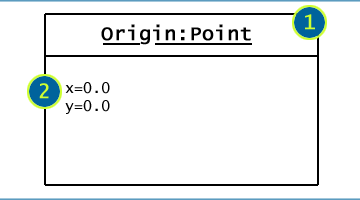Object Diagram Example

- An object diagram is deliberately similar to a class diagram. It is divided into two compartments. The top compartment holds the name of the object, followed by a colon and the name of the class. Both the name of object and the name of the class are underlined.
- The bottom compartment holds the names of the object's attributes and their values, here 0.0 and 0.0. The type is omitted, though it is often implicit in the values. Using the equal sign makes it clear you are showing the value.
UML Object Diagram
An object diagram in the Unified Modeling Language (UML), is a diagram that shows a complete or partial view of the structure of a modeled system at a specific time.
An object diagram focuses on some particular set of objects and attributes, and the links between these instances. A correlated set of object diagrams provides insight into how an arbitrary view of a system is expected to evolve over time. In early UML specifications the object diagram is described as:
Object diagrams and class diagrams are closely related and use almost identical notation. Both diagrams are meant to visualize the static structure of a system. Object diagrams displays instances of classes (objects) Object diagrams are more concrete than class diagrams. They are often used to provide examples or act as test cases for class diagrams.
An object diagram focuses on some particular set of objects and attributes, and the links between these instances. A correlated set of object diagrams provides insight into how an arbitrary view of a system is expected to evolve over time. In early UML specifications the object diagram is described as:
An object diagram is a graph of instances, including objects and data values. A static object diagram is an instance of a class diagram; it shows a snapshot of the detailed state of a system at a point in time. The use of object diagrams is fairly limited, namely to show examples of data structure.
Object diagrams and class diagrams are closely related and use almost identical notation. Both diagrams are meant to visualize the static structure of a system. Object diagrams displays instances of classes (objects) Object diagrams are more concrete than class diagrams. They are often used to provide examples or act as test cases for class diagrams.